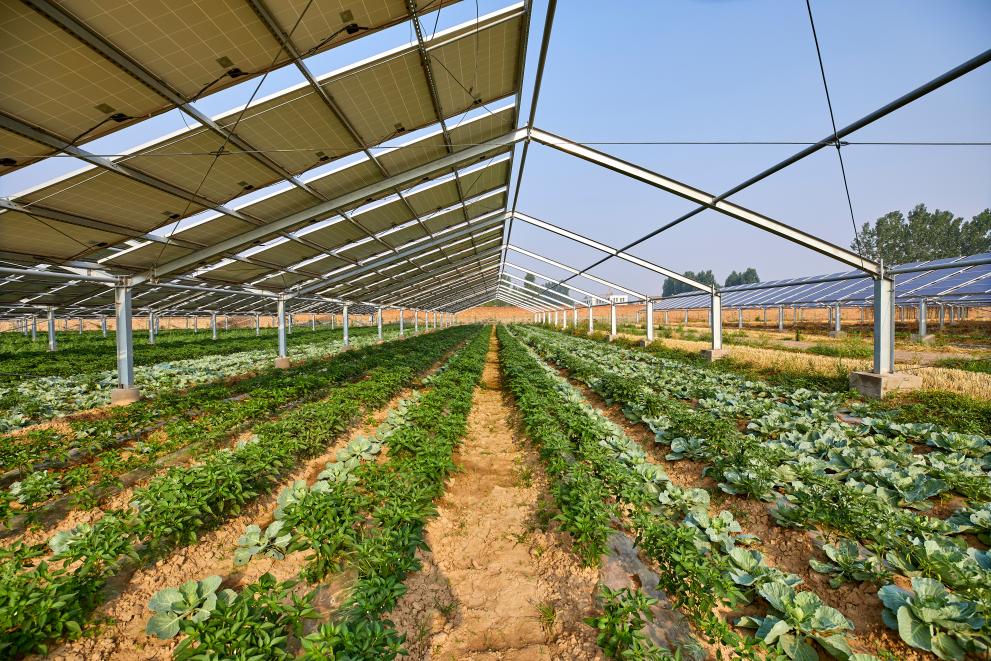
Combining farming and solar photovoltaic electricity production – known as agrivoltaics - on a mere 1% of EU utilised agricultural area (UAA) could help to surpass the EU’s 2030 targets - 720 GW direct current - for solar energy generation.
This innovative multi land-use application shows great potential: unlike conventional ground mounted photovoltaic systems, in agrivoltaic applications the panels are installed in such a way that agricultural activities, such as growing crops, grass or fruit, remain the primary use of the land area, while also giving access for farm machinery or livestock.
The panels can provide shadowing to mitigate heat stress on crops and offer protection from severe weather. Likewise, greenhouses can be made of semi-transparent PV panels.
Agrivoltaics can help alleviate concerns about land competition between solar panels and farming activities, while supporting policies related to energy transition, agriculture, the environment and biodiversity in the EU's pursuit of the European Green Deal targets for a climate neutral Europe.
A JRC report, Overview of the Potential and Challenges for Agri-Photovoltaics in the European Union, explores the status of agrivoltaic systems, identifies potential hurdles and presents a series of recommendations for enabling and accelerating their expansion.
Photovoltaic (PV) panels produce direct current (DC), then converted in alternating current (AC), to be used directly or injected into the electric grid. The PV DC to AC conversion is approximately 1/1.25.
At the end of 2022, the installed capacity in the EU was around 211 GWDC. According to the study, covering just 1% of the utilised agricultural area (UAA) with agrivoltaic systems could result in approximately 944 GWDC of installed capacity. This amounts to half of the capacity possible with traditional ground-mounted PV systems (around 1,809 GWDC on the same surface area). However, it would still be greater than the 720 GWDC capacity foreseen by 2030 in the EU Solar Energy Strategy.
Put forward by the European Commission in May 2022, the strategy is essential to the massive, rapid deployment of renewable energies, envisaged by the REPowerEU plan to reduce EU dependency on Russia’s fossil fuels. In order to achieve the ambitious targets for solar energy, it encourages Member States to consider not only utility-scale solar and rooftop solar, but also innovative forms of solar energy deployment, including agrivoltaics.
However, the lack of a clear and EU-harmonised definition of agrivoltaic presents a significant obstacle, as the installation of such systems may lead to changes in land characterisation, which could affect eligibility for agricultural subsidies and for taxation.
Additional challenges include maximising electricity production without affecting crop yield and ensuring biodiversity preservation and nature restoration; complex permitting and grid connection procedures as well as land prices increase that could jeopardise the welfare and security of farmers.
To overcome these barriers, the EU Solar Energy Strategy encourages EU countries to integrate incentives for agrivoltaics, as appropriate, when designing and implementing their common agricultural policy (CAP) national strategic plans. Further incentives can be provided through support frameworks for solar energy (e.g. through the integration of agrivoltaics in renewable energy tenders). It is also worth noting that, in the agricultural sector, state aid rules allow investment aid to sustainable energy.
Assistance could highlight financial support, simplified permit and grid connection procedures, research and development (R&D) programmes, and pilot projects. Moreover, engaging rural communities in the planning and decision-making process is essential for the successful expansion of agrivoltaic systems. Communities must be aware of the benefits of agrivoltaic systems, including their potential to generate clean energy, increase agricultural productivity, and contribute to sustainable rural development.
Related content
REPowerEU plan
Details
- Publication date
- 12 October 2023
- Author
- Joint Research Centre
- JRC portfolios




